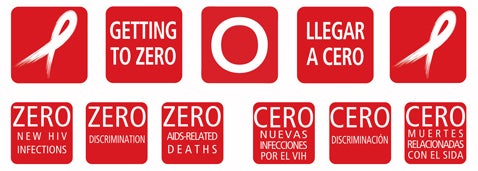

Increased access to antiretroviral treatment has changed the face of the HIV epidemic in Latin America and the Caribbean, helping tens of thousands of people to live longer and healthier lives while also helping prevent HIV transmission between sexual partners and from mothers to infants.
Washington, D.C., 30 November 2012 (PAHO/WHO) — Increased access to antiretroviral treatment has changed the face of the HIV epidemic in Latin America and the Caribbean, helping tens of thousands of people to live longer and healthier lives while also helping prevent HIV transmission between sexual partners and from mothers to infants.

Building on this success—say experts at the Pan American Health Organization/World Health Organization (PAHO/WHO)—can help countries in Latin America and the Caribbean achieve the goals of the global World AIDS Day 2012 campaign: "Getting to Zero: Zero new HIV infections. Zero deaths from AIDS-related illness. Zero discrimination."
"Since the beginning of the AIDS epidemic, the countries of the Americas have come a long way. Our countries' efforts show encouraging results, which in turn motivates us to continue our work," said PAHO/WHO Assistant Director Dr. Socorro Gross. "Our region continues to show strong leadership in prevention, treatment, and providing care to those in need."
Latin America and the Caribbean have the highest level of antiretroviral treatment coverage of any mid-low income region in the world, with an estimated 68% of people who need treatment receiving it in Latin America, and 67% in the Caribbean. According to WHO and UNAIDS data, at least four countries in the region—Cuba, the Dominican Republic, Guyana, and Mexico—have achieved universal access to treatment, and 10 others are close to achieving that goal.
The region has also made great progress in preventing mother-to-child transmission of HIV. The number of children born with HIV has declined 32% in the Caribbean since 2001, and 24% in Latin America.
Studies show that the same medicines that save lives and keep people with HIV healthy can also prevent HIV transmission between sexual partners and from mothers to infants. In a new set of guidelines for treating people with HIV who have uninfected partners, WHO recommends offering antiretroviral therapy to the HIV-positive partner as early as possible and regardless of the status of his or her immune system, to reduce the likelihood of HIV transmission to the uninfected partner.
"These new developments reinforce the importance of an integrated approach toward HIV prevention, treatment and care, and alignment with programs and services for maternal and child health, sexual and reproductive health, adolescent health, and others," said Dr. Gina Tambini, PAHO Area Manager for Family and Community Health.
"This is a very opportune time for the HIV response," said Dr. Massimo Ghidinelli, Coordinator of PAHO's HIV/STI Prevention, Treatment and Care Project. "With evidence-based interventions and sound public health principles, we now see the potential to make the HIV response more sustainable and accelerate our progress toward achievement of the target of zero new infections and zero AIDS-related deaths."
PAHO is marking World AIDS Day with the launch on Nov. 30 of a new exhibit, United Colors of HIV, by the Argentine artist Fabián Rios Rubino. The exhibit was inspired by a 1991 United Colors of Benetton ad campaign showing a man with AIDS on his deathbed, surrounded by his family. The goal of the exhibit is to show how the HIV/AIDS paradigm has changed since then.
"Although people are still dying of AIDS, those who have access to medical treatment can live longer, better lives," says Rios Rubino in his artist's statement for the exhibit.
Expanding treatment has helped lower AIDS mortality rates globally and in the Americas region. Between 2005 and 2011, the number of AIDS deaths declined 20% in the region.
Some population groups, however, still have difficulty accessing HIV prevention and treatment services. Barriers include geographical factors as well as stigma, discrimination and legal issues. Men who have sex with men, people who use drugs, sex workers, and adolescent girls remain vulnerable and often marginalized. As a result, they may not obtain the health services they need, including early access to antiretroviral therapy. Migrants also frequently have limited access to the services they need.
In 2011, an estimated 2.5 million adults worldwide were newly infected with HIV, and 1.7 million people died from HIV-related causes. That is about 700,000 fewer new infections than 10 years ago and 600,000 fewer deaths than in 2005. Currently an estimated 8 million people in low- and middle-income countries are accessing the treatment they need, up from only 0.4 million in 2003.
The global community has agreed to maintain the World AIDS Day 2012 theme "Getting to Zero" for the next three years, through 2015, the global target date for achieving universal access to HIV treatment.
PAHO, which celebrates its 110th anniversary this year, is the oldest international public health organization in the world. It works with its member countries to improve the health and the quality of life of the people of the Americas. It also serves as the Regional Office for the Americas of WHO.
Links:
- PAHO HIV web site
- Message of UN Secretary General Special Envoy for HIV in the Caribbean
- WHO Media Center on HIV/AIDS
- 10 facts on HIV/AIDS
- WHO page on HIV/AIDS
- UNAIDS World AIDS Day report 2012
Media Contacts:
Leticia Linn, linnl@paho.org, Tel. + 202 974 3440, Mobile +1 202 701 4005, Donna Eberwine-Villagran, eberwind@paho.org, Tel. +1 202 974 3122, Mobile +1 202 316 5469, Sebastián Oliel, oliels@paho.org, Phone +1 202 974 3459, Mobile 202 316 5679, Knowledge Management and Communications, PAHO/WHO—www.paho.org



